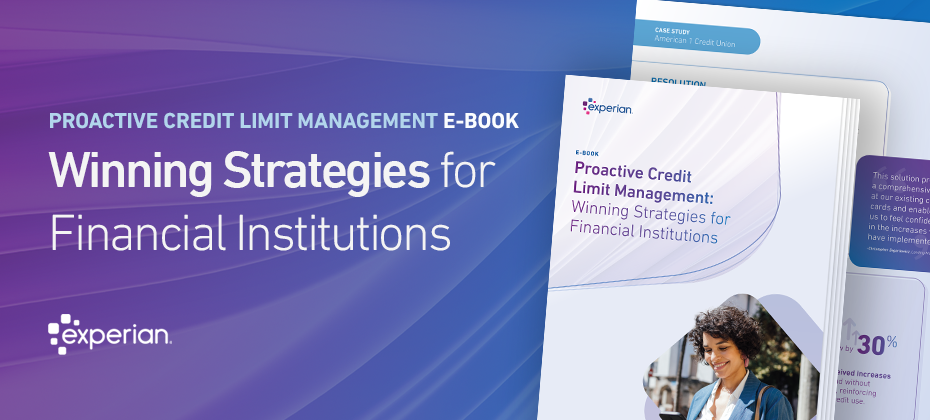Tag: credit

Mid-sized banks are large enough to pursue ambitious growth strategies, like expanding loan portfolios or entering new markets, but not so large that they can withstand major credit losses without consequence. So how do lending organizations manage their credit risk strategies to grow without taking on more risk than they can handle?

Credit decisioning has traditionally relied on static data like credit bureau scores, income statements, and past repayment history. As financial behavior becomes more dynamic and consumer expectations shift toward instant decisions, real-time data is emerging as a powerful tool in reshaping how lenders assess risk.

Managing credit limits effectively can be a game-changer for both consumers and financial institutions. Understanding the benefits and behaviors associated with increased credit limits helps in appreciating the long-term impacts of this strategy. Proactive credit limit management offers numerous advantages that can significantly improve financial health and stability.

Managing credit limits effectively is vital for maintaining a profitable and resilient credit card portfolio. By adopting a proactive credit limit management approach, financial institutions can significantly improve customer satisfaction and increase revenue. As of Q3 2024, the average credit card limit in the U.S. stood at $32,025, marking a 4.1% rise from $30,763 the previous year.1 Proper management of these limits is crucial for financial institutions, as it impacts consumer borrowing capacity and overall financial health. Advantages of proactive credit limit increases A proactive credit limit increase occurs when a credit card issuer raises a cardholder’s credit limit without their request. This action is usually dependent on improvements to cardholders’ creditworthiness, including consistent, on-time payments and a reduction in debt. Proactive increases can enable financial institutions to: Increase interchange income: When financial institutions increase credit limits, they can boost transaction volumes, leading to higher interchange income. Generate additional interest income: Higher credit limits can lead to increased borrowing, resulting in more interest income for financial institutions. Enhance wallet share: By proactively increasing credit limits, institutions can encourage cardholders to use their cards more frequently, thereby increasing wallet share. Reduce customer attrition: When cardholders feel valued and supported, they are more likely to remain loyal to their financial institution. Proactive credit limit increases can reduce attrition rates by enhancing customer satisfaction and loyalty. Improve customer experience: Cardholders value the convenience and flexibility of higher credit limits, which can lead to increased satisfaction, positive sentiment and potential referrals. Implementing proactive credit limit increases To successfully implement proactive credit limit increases, financial institutions must address two key questions: Who receives an increase? Use insights to identify cardholders who meet the criteria for credit limit increases. Continuously monitor cardholders’ creditworthiness using advanced tools and technologies to ensure that only responsible cardholders receive increases. How much of an increase? Determine customers’ ability to afford additional credit by evaluating their annual income, debt-to-income ratio, and payment-to-income ratio. Set thresholds for these metrics to guide the decision-making process. Proactive credit limit management Effective credit limit management is essential for financial institutions aiming to grow their credit card portfolios and enhance customer satisfaction. Read this e-book on proactive credit limit management and discover how your institution can improve wallet share, enhance customer experience, and drive revenue. Read the e-book 1 Experian, Average Credit Card Debt Increases 3.5% to $6,730 in 2024.

Getting customers to respond to your credit offers can be difficult. With the advent of artificial intelligence (AI) and machine learning (ML), optimizing credit prescreen campaigns has never been easier or more efficient. In this post, we'll explore the basics of prescreen and how AI and ML can enhance your strategy. What is prescreen? Prescreen involves evaluating potential customers to determine their eligibility for credit offers. This process takes place without the consumer’s knowledge and without any negative impact on their credit score. Why optimize your prescreen strategy? In today's financial landscape, having an optimized prescreen strategy is crucial. Some reasons include: Increased competition: Financial institutions face stiff competition in acquiring new customers. An optimized prescreen strategy helps you stand out by targeting the right individuals with tailored offers, increasing the chances of conversion. Customer expectations: Modern customers expect personalized and relevant offers. An effective prescreen strategy ensures that your offers resonate with the specific needs and preferences of potential customers. Strict budgets: Organizations today are faced with a limited marketing budget. By determining the right consumers for your offers, you can minimize prescreen costs and maximize the ROI of your campaigns. Regulatory compliance: Compliance with regulations such as the Fair Credit Reporting Act (FCRA) is essential. An optimized prescreen strategy helps you stay compliant by ensuring that only eligible individuals are targeted for credit offers. Financial inclusion: 49 million American adults don’t have conventional credit scores. An optimized prescreen strategy allows you to send offers to creditworthy consumers who you may have missed due to a lack of traditional credit history. How AI and ML can enhance your strategy AI and ML can revolutionize your prescreen strategy by offering advanced analytics and custom response modeling capabilities. AI-driven data analytics AI analytics allow financial institutions to analyze vast amounts of data quickly and accurately. This enables you to identify patterns and trends that may not be apparent through traditional analysis. By leveraging data-centric AI, you can gain deeper insights into customer behavior and preferences, allowing for more precise targeting and increased response rates. LEARN MORE: Explore the benefits of AI for credit unions. Custom response modeling Custom response models enable you to better identify individuals who fall within your credit criteria and are more likely to respond to your credit offers. These models consider various factors such as credit history, spending habits, and demographic information to predict future behavior. By incorporating custom response models into your prescreen strategy, you can select the best consumers to engage, including those you may have previously overlooked. LEARN MORE: AI can be leveraged for numerous business needs. Learn about generative AI fraud detection. Get started today Incorporating AI and ML into your prescreen campaigns can significantly enhance their effectiveness and efficiency. By leveraging Experian's Ascend Intelligence Services™ Target, you can better target potential customers and maximize your marketing spend. Our optimized prescreen solution leverages: Full-file credit bureau data on over 245 million consumers and over 2,100 industry-leading credit attributes. Exclusive access to the industry's largest alternative datasets from nontraditional lenders, rental data inputs, full-file public records, and more. 24 months of trended data showing payment patterns over time and over 2,000 attributes that help determine your next best action. When it comes to compliance, Experian leverages decades of regulatory experience to provide the documentation needed to explain lending practices to regulators. We use patent-pending ML explainability to understand what contributed most to a decision and generate adverse action codes directly from the model. For more insights into Ascend Intelligence Services Target, view our infographic or contact us at 855 339 3990. View infographic This article includes content created by an AI language model and is intended to provide general information.

Financial institutions are constantly searching for ways to engage their consumers while providing valuable services that keep them financially sound and satisfied. At the same time, consumers are looking for ways to limit their risk and grow their financial power while improving and protecting their financial health. Both can be accomplished through personalized financial experiences.

During the last couple of years, volatile market conditions have made it more difficult for consumers to improve their finances. In addition, a lack of financial literacy has negatively impacted consumers’ ability to expand their buying power. This can include opening new lines of credit, which is a source of revenue for financial institutions. Empowering your consumers with credit education and resources can create opportunities for them to open more of these new accounts, which can help lead to additional revenue for your business. Credit card account openings decreased in 2023 Economic turbulence is affecting businesses everywhere, including financial institutions. Uncertain market conditions have forced banks and credit unions to take revenue-preserving actions, such as tightening their credit card loan standards for consumers. As a result, credit card digital account opening growth slowed in 2023, and the trend threatens to continue.[1] This decrease in the opening of new credit card accounts can negatively affect lenders that aim to grow their business by encouraging consumers to borrow more money. Consumers’ financial literacy also plays a role in their ability and inclination to open new accounts. Uninformed consumers may be less likely to open new accounts Without a strong understanding of finances, many consumers find themselves in an unfavorable financial situation. Less than 30% of Americans have a financial plan,[2] and lacking financial knowledge cost individuals $1,819 on average in 2022.[3] Consumers without basic knowledge of finance or credit best practices usually have lower credit scores and may be less likely to qualify for credit card offers with low interest rates. So, what can financial institutions do to counteract decreasing credit card account openings? Help improve consumers credit standing with credit education Credit education programs can have a positive effect on consumers’ credit standing and general understanding of healthy financial habits. More than 65% of consumers enrolled in a credit education program see an improvement on their credit scores.[4] Credit-educated individuals can typically attain higher credit scores, which can help improve their chances of meeting the more restrictive credit standards banks have put in place due to volatile market conditions. Consumers who are better informed about credit and finances make better financial decisions, save, and borrow more money, and may be more likely to open new credit card accounts. This presents a valuable opportunity for financial institutions to offer highly desired credit education services to the consumers who need it. Deliver services your customers want A recent study showed that 57% of consumers want their financial institution to provide resources and support to help them better manage their finances, and 54% feel that their bank is responsible for teaching strong financial habits.[5] Consumers expect these financial services from the banks they do business with. Refraining from offering them could put your business at a disadvantage when compared to the banks that do. Make sure the services you provide include credit education that empowers your consumers to become more financially confident. This can help drive consumers to borrow more money and potentially open more new credit lines, which can drive additional revenue for your business. Learn more about how offering credit education services can help your consumers save more, borrow more, and open more new accounts. Visit our website [1] eMarketer, Credit Card Marketing 2023. [2] BusinessDIT, The State of Financial Planning, April 2023. [3] National Financial Educators Council, Cost of Financial Illiteracy Survey, 2023. [4] Experian Internal Data, 2023 credit lift study for users tracked from Dec 2020 – Dec 2022. [5] MX Technologies Inc. What Influences Where Consumers Choose to Bank. 2023.

Generation Z, or people born between 1997 and 2012, make up about 27% of the American population[1] and have $360B in disposable income[2]. While they may be a young demographic now, Gen Z will soon represent a significant portion of buyers and borrowers in the United States, creating an enormous opportunity for financial institutions to start engaging with them now. Here are three reasons why you should be marketing financial services to Gen Z. Improving financial wellness is a priority for Gen Z Gen Z is a pragmatic cohort of consumers, but they’re also uncertain and anxious about their financial future. The top concern amongst Gen Z is the cost of living. For these reasons, businesses have a unique opportunity to help those consumers feel less stressed and more confident by providing them with financial services. This can turn those consumers into loyal, long-standing customers. Gen Z has the lowest credit score of any generation Gen Z ranks lowest in average and median VantageScore® credit score* compared to all other generations, including Gen Y (or millennials), Gen X, and baby boomers.[4] While this is partially due to Gen Z being younger than the others, it’s also a result of having shorter credit histories and fewer lines of credit. This presents a great chance for businesses to help Gen Z individuals establish responsible financial habits, such as opening a new line of credit to begin building a healthy credit history. Gen Z is actively seeking support now Consumers in the Gen Z age range recognize the importance of personal finance, but they also realize that they don’t have the knowledge needed to be successful. While people in Gen Z are still young (currently between the ages of about 11 and 26), many need guidance now for their financial wellness and many need help to keep their financial future secure. This means now is the perfect time to start building a lifetime relationship with them and become a trusted advisor by providing financial products and services to help them through their financial journey. There are about 72 million Americans in the Gen Z demographic[1]. A large percentage of this group may feel strongly about improving their financial wellness. With high levels of financial stress and generally low credit scores, many of them are looking for companies they can trust to help them build good credit and take control of their personal finances. Since 2019, the number of consumers under the age of 30 enrolled in Experian Partner Solutions credit monitoring and identity protection services has doubled from 9% to 18%. Offering these financial tools to Gen Z is essential to building their trust and financial wellness, which can lead to an increase in future acquisition, retention, and revenue for your business. Click here to learn more *Calculated on the VantageScore® model. Your VantageScore® credit score from Experian® indicates your credit risk level and is not used by all lenders, so don’t be surprised if your lender uses a score that’s different from your VantageScore® credit score. Click here to learn more. [1] Insider Intelligence. 2023. Generation Z News: Latest characteristics, research, and facts. [2] Forbes. 2022. As Gen Z’s Buying Power Grows, Businesses Must Adapt Their Marketing. [3] Deloitte. Deloitte Gen Z and Millennial Survey 2022. Jan 2022. [4] Experian State of Credit Report. 2021. [5] Greenlight Financial Technology, Inc. Survey finds Gen Z lacks knowledge and confidence in personal finance and investing. 2021. [6] NAPFA. NAPFA Survey on Americans’ sources for financial planning and retirement investing advice. 2021.

Experian’s State of the Automotive Finance Market Report: Q3 2022 found that consumers with credit scores between 300 and 660—also considered as the nonprime segments—are continuing to opt for used vehicles rather than new.

With consumers having more credit options than ever before, it’s imperative for lenders to get their message in front of ideal customers at the right time and place. But without clear insights into their interests, credit behaviors or financial capacity, you may risk extending preapproved credit offers to individuals who are unqualified or have already committed to another lender. To increase response rates and reduce wasted marketing spend, you must develop an effective customer targeting strategy. What makes an effective customer targeting strategy? A customer targeting strategy is only as good as the data that informs it. To create a strategy that’s truly effective, you’ll need data that’s relevant, regularly updated, and comprehensive. Alternative data and credit-based attributes allow you to identify financially stressed consumers by providing insight into their ability to pay, whether their debt or spending has increased, and their propensity to transfer balances and consolidate loans. With a more granular view of consumers’ credit behaviors over time, you can avoid high-risk accounts and focus only on targeting individuals that meet your credit criteria. While leveraging additional data sources can help you better identify creditworthy consumers, how can you improve the chances of them converting? At the end of the day, it’s also the consumer that’s making the decision to engage, and if you aren’t sending the right offer at the precise moment of interest, you may lose high-value prospects to competitors who will. To effectively target consumers who are most likely to respond to your credit offers, you must take a customer-centric approach by learning about where they’ve been, what their goals are, and how to best cater to their needs and interests. Some types of data that can help make your targeting strategy more customer-centric include: Demographic data like age, gender, occupation and marital status, give you an idea of who your customers are as individuals, allowing you to enhance your segmentation strategies. Lifestyle and interest data allow you to create more personalized credit offers by providing insight into your consumers’ hobbies and pastimes. Life event data, such as new homeowners or new parents, helps you connect with consumers who have experienced a major life event and may be receptive to event-based marketing campaigns during these milestones. Channel preference data enables you to reach consumers with the right message at the right time on their preferred channel. Target high-potential, high-value prospects By using an effective customer targeting strategy, you can identify and engage creditworthy consumers with the greatest propensity to accept your credit offer. To see if your current strategy has what it takes and what Experian can do to help, view this interactive checklist or visit us today. Review your customer targeting strategy Visit us

Whether your goal is to gain new business or create cross-sell opportunities, being proactive in your credit marketing approach can help drive higher response rates and more meaningful customer experiences. But without knowing when your ideal customers are actively seeking credit, you may risk losing business to lenders who have already engaged. So, how can you identify new opportunities when they occur? Given that 91% of consumers say they’re more likely to shop with brands that provide relevant offers, you’ll need to reach the right consumers at the right moment to increase response rates and stay ahead of competitors. Event-based credit triggers can help you identify new tradelines, inquiries and certain loans nearing term to locate highly responsive, credit-active individuals. By receiving updates on consumers’ recent credit activities, you can make firm credit offers immediately so you never miss an opportunity. Case Study: Deliver timely offers with credit trigger leads Vantage West Credit Union serves over 170,000 members across Arizona. With their members looking elsewhere for their mortgage needs, Vantage West aimed to drive as many of these members back to the credit union as possible. To do this, they looked for a solution that could help them identify and target members who are in the market for a new mortgage. By augmenting their prescreen process with Experian’s Prospect Triggers for mortgages, the credit union was able to quickly pinpoint consumers that not only met their credit criteria but were also likely to respond to their credit offers. Within two years of implementing Prospect Triggers, Vantage West funded an additional $18 million in mortgages and is continuing to grow by making timely offers to credit-active prospects. Prospect Triggers is available for banks, credit card issuers, mortgage lenders, retailers and automotive lenders. To learn how Experian can help bring precision and profitability to your credit marketing campaigns, read the full case study or visit us. Download the case study Visit us

Rapid improvements in technology and the rise in online activity are driving higher consumer expectations for fast and frictionless digital experiences. And yet, only 50% of credit unions are executing on a digital strategy compared to 79% of banks.1 What can credit unions do to stand out from the competition and keep up with increasing consumer demands? 23% of consumers say their expectations for the digital experience have only somewhat or not at all been met.2 The answer lies in digital prequalification. With a frictionless digital prequalification solution, members can prequalify themselves online in real time before starting the formal application process. This puts members in the driver’s seat, allowing them to see their eligibility for credit offers and choose whether they’d like to proceed with the application. By delivering immediate feedback and offers to members online, credit unions can increase response rates, improve digital engagement and enhance the prequalification experience. Case Study: Achieving growth through a seamless digital prequalification experience Gather Federal Credit Union is the largest neighbor-island credit union in Hawaii, providing financial products and services to more than 35,000 members. Wanting to grow more loans while providing members with a seamless and efficient online experience, the credit union looked for a comprehensive solution that could improve their decisioning and enhance their prequalification strategy. They partnered with Experian and Rate Reset to implement a frictionless digital experience that enables members to opt-in for prequalified offers. Leveraging the power of Experian’s PowerCurve® and Rate Reset’s The ButtonTM, Gather had flexible access to consumer data, attributes and scores, allowing them to verify user identities and match members with loan products before their application formally went through the credit underwriting process. By gaining a better understanding of which credit options they prequalified for, members were able to opt-in instantly, creating a faster, more personalized digital prequalification experience. Within three weeks of implementation, Gather booked over $600,000 in new personal loans and credit cards. Additionally, of all the applicants that passed the credit union’s credit prequalification criteria, 54% accepted their offer and received a loan. “With a few clicks, members and non-members alike can instantly prequalify themselves for a loan. We’re extremely pleased with this offering, which has enabled us to extend our reach and grow the Gather community,” said Justin Ganaden, Executive Vice President, Gather Federal Credit Union. Read the full case study to learn more about how Experian can help grow your business with a frictionless digital prequalification experience. Download the full case study 1 https://www.big-fintech.com/Media/BIG-News/ArticleID/779/New-Digital-Banking-Platform Digital Transformation Revolution – Is it Leaving Credit Unions Behind? 2 2022 Global Insights Report, Experian, 2022.

Millions of consumers are excluded from the credit economy, whether it’s because they have limited credit history, dated information within their credit file, or are a part of a historically disadvantaged group. Without credit, it can be difficult for consumers to access the tools and services they need to achieve their financial goals. This February, Experian surveyed over 1,000 consumers across census demographics, including income, ethnicity, and age, to understand the perceptions, needs, and barriers underserved communities face along their credit journey. Our research found that: 75% of consumers with an average household income of less than $50,000 have less than $1,000 in savings. 1 in 5 consumers with an average household income of less than $35,000 say they’re confident in getting approved for credit. 80% of respondents who are not or slightly confident in getting approved for credit were women. When asked why they believed they would not get approved for credit, participants shared common responses, such as having poor payment history, a low credit score, and insufficient income. Given these findings, what can lenders provide to help underserved consumers strengthen their financial profiles and gain access to the credit they need and deserve? The power of credit education While only 20% of respondents were familiar with credit education tools, the majority expressed interest in these offerings. With Experian, lenders can develop and implement credit education programs, tools, and solutions to help consumers understand their credit and the impact certain choices can have on their credit scores. From interactive tools like Score Simulator and Score Planner to real-time alerts from Credit Monitoring, consumers can actively assess their financial health, take steps to improve their creditworthiness, and ultimately become better candidates for credit offers. In turn, consumers can feel more confident and empowered to achieve their financial goals. Credit education tools not only help consumers increase their credit literacy, confidence, and chances of approval, but they also create opportunities for lenders to build lasting customer relationships. Consumers recognize that healthy credit plays an important role in their financial lives, and by helping them navigate the credit landscape, lenders can increase engagement, build loyalty, and enhance their brand’s reputation as an organization that cares about their customers. Empowering consumers with credit education is also a way for lenders to unlock new revenue streams. By learning to borrow, save, and spend responsibly, consumers can improve their creditworthiness and be in a better position to accept extended credit offerings, driving more cross-sell and upsell opportunities for lenders. More ways experian can help Experian is deeply committed to helping marginalized and low-income communities access the financial resources they need. In addition to our credit education tools, here are a few of our other offerings: Our expanded data helps lenders make better lending decisions by providing greater visibility and transparency around a consumer’s inquiry and payment behaviors. With a holistic view of their current and prospective customers, lenders can more accurately identify creditworthy applicants, uncover new growth opportunities, and expand access to credit for underserved consumers. Experian GoTM is a free, first-of-its-kind program to help credit invisibles and those with limited credit histories begin building credit on their own terms. After authenticating their identities and obtaining an Experian credit report, users will receive ongoing education about how credit works and recommendations to further build their credit history. To learn more about building profitable customer relationships with credit education, check out our credit education solutions and watch our Three Ways to Uncover Financial Growth Opportunities that Benefit Underserved Communities webinar. Learn more Watch webinar

As more consumers apply for credit and increase their spending1, lenders and financial institutions have an opportunity to expand their portfolios and improve profitability. The challenge is ensuring they’re extending credit responsibly and inclusively. Millions of Americans, many of whom are creditworthy, lack access to mainstream credit options. This may be because they have limited or no credit history, negative information within their credit file, or are a part of a historically disadvantaged group. To say “yes” to consumers they otherwise couldn’t or wouldn’t lend to, lenders must gain a deeper understanding of an individual’s stability, ability and willingness to pay. That’s where expanded FCRA-regulated and trended data come in. While traditional credit data has long been the primary means of gauging creditworthiness, it doesn’t tell the full story of a consumer’s financial situation. Let’s explore how differentiated data can help lenders make more informed credit decisions. Using differentiated data for deeper lending Expanded FCRA-regulated data provides supplemental credit data to help lenders gain a more holistic view of their current and prospective customers. Some examples of expanded FCRA-regulated data include alternative financial services data from nontraditional lenders, consumer-permissioned account data, rental payments and full-file public records. Because this data drives greater visibility and transparency around inquiry and payment behaviors, lenders can more accurately determine a consumer’s ability to pay and distinguish between reliable and high-risk applicants. In turn, lenders can approve more creditworthy consumers, grow their portfolios and increase financial opportunities for underserved communities, all while preventing and mitigating risk. 89% of lenders agree that expanded FCRA-regulated data allows them to extend credit to more consumers. Trended data empowers lenders with predictive insights into consumers by providing key balance and payment data for the previous 24 months. This is important as lenders can determine if a consumer’s credit behavior has improved or deteriorated over time. In turn, lenders can: Identify creditworthy customers: Establish if a consumer has a demonstrated ability to pay, is consistently paying more than the minimum payment, or shows no signs of payment stress. Increase response rates: Match the right products with the right prospects. Determine upsell and cross-sell opportunities: Present relevant offers based on anticipated needs and behaviors. Limit loss exposure: Understand the direction and velocity of payment performance to effectively manage risk exposure. Trended data helps lenders better predict future behavior, manage portfolio risk and design the best marketing offers. Turning insights into action Together, trended and expanded FCRA-regulated data benefit lenders and consumers alike. With a more holistic view of their customers, lenders gain powerful insights to lend deeper, ultimately helping them to expand their portfolios and drive greater access to credit for underserved communities. Learn more 1 The Recovery of Credit Applications to Pre-Pandemic Levels, Consumer Financial Protection Bureau, 2021.

No two customers are the same. That’s why it’s important to go beyond the traditional credit score for a closer look at each consumer’s individual circumstance and create personalized response plans. Learn more about some of the many different customers you’ll encounter and download our guide to get recommendations for every stage of the lifecycle. Get the Guide